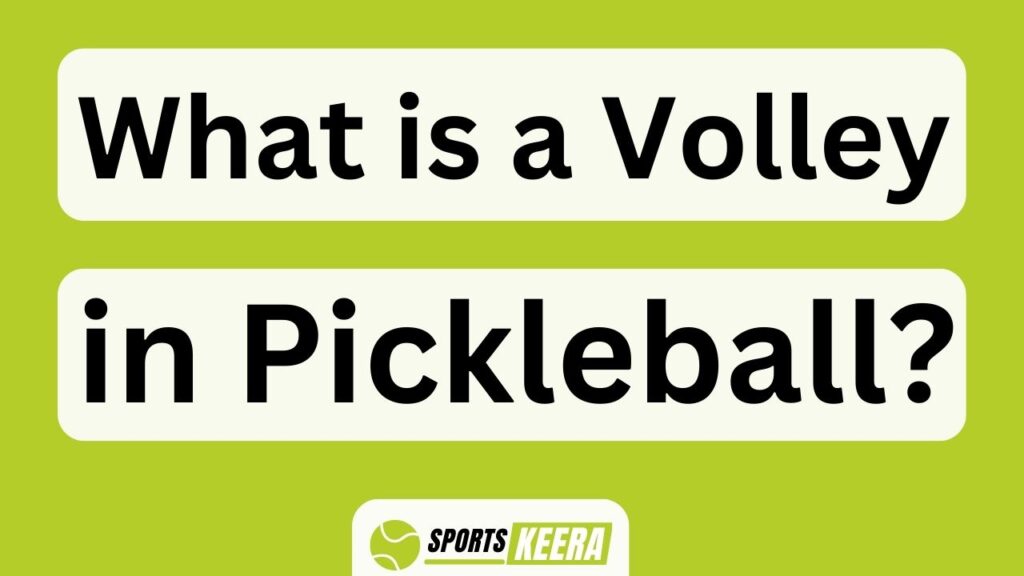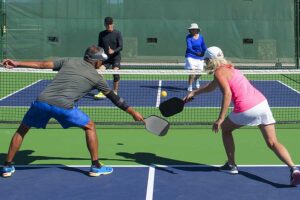Pickleball, a sport that combines elements of tennis, badminton, and table tennis, has been gaining popularity in recent years. For those new to the game, understanding its unique terminology is essential to fully enjoy and participate. One such term that often leaves beginners puzzled is the ‘volley.’ While it may sound like something from a bygone era, volleys are actually an integral part of pickleball strategy and gameplay.
In simple terms, a volley in pickleball refers to hitting the ball in mid-air before it bounces on your side of the court. Unlike other sports where players typically let balls bounce before returning them, volleys require quick reflexes and precise timing. They allow players to maintain control over the game and put pressure on their opponents.
In this article, we will delve into the different types of volleys used in pickleball, explore proper techniques for executing them effectively, discuss common mistakes to avoid, and provide drill and practice ideas to help you improve your volley skills. So grab your paddle and get ready to elevate your game with some expert tips!
Key Takeaways What Is A Volley In Pickleball?
- A volley in pickleball is a shot that is executed in mid-air before the ball bounces on your side of the court.
- Volleys require quick reflexes, precise timing, and proper technique including grip, footwork, and body positioning.
- Offensive volleys aim to put pressure on opponents and can be executed with a firm grip.
- There are different types of volleys in pickleball, including the punch volley and the soft touch or dink volley.
A Brief Introduction to Pickleball
You may be interested in learning that pickleball is a paddle sport that combines elements of tennis, badminton, and table tennis. Played on a court with the same dimensions as a doubles badminton court, pickleball can be enjoyed by people of all ages and skill levels.
Understanding pickleball rules is essential to playing the game correctly. The objective is to hit a plastic ball over the net without it being returned by your opponent. Serving diagonally, players must let the ball bounce once before volleys are allowed. This unique rule adds an exciting strategic element to the game.
In addition to being fun and challenging, playing pickleball offers numerous benefits such as improving hand-eye coordination, promoting cardiovascular health, and providing social interaction.
Now let’s delve into understanding the basics of pickleball.
Understanding the Basics of Pickleball
With its quick pace and small court size, understanding the fundamentals of this popular sport can be an exhilarating experience.
Pickleball is a unique combination of tennis, badminton, and ping pong, played on a smaller court with solid paddles and a plastic ball with holes.
The rules of pickleball are similar to those of tennis, but there are some key differences. Players must serve diagonally and the serve must clear the non-volley zone, also known as the kitchen. Once the ball is in play, players cannot enter the non-volley zone unless they’re volleying or hitting a groundstroke from behind it. This rule encourages quick reflexes and strategic shot placement.
Understanding these rules and using proper pickleball equipment is essential for success in this fast-paced game.
Now that we’ve covered the basics of pickleball, let’s move on to explaining the concept of a volley without stepping into the next section too abruptly.
Explaining the Concept of a Volley
Now that we’ve covered the basics, let’s dive into understanding how players can make quick shots without stepping into the non-volley zone.
In pickleball, a volley refers to hitting the ball in mid-air before it bounces on the ground. It requires precise timing and technique to execute effectively. To successfully perform a volley, players must position themselves near the net, just behind the kitchen line. This positioning allows them to reach the ball quickly and maintain control over their shots.
This positioning also enables players to put pressure on their opponents by returning fast-paced shots while staying close to the net for potential winning opportunities. Mastering the volley technique is essential for both offensive and defensive play in pickleball.
Now that we understand what a volley is and its importance in gameplay, let’s explore different types of volleys in pickleball without skipping a beat.
Different Types of Volleys in Pickleball
The first type of volley that players can utilize in pickleball is the punch volley. This involves quickly punching the ball with a closed fist, which adds power and precision to their shot. The punch volley is commonly used when players are closer to the net and want to put more force behind their shot.
Another type of volley is the soft touch or dink volley, where players use a softer grip and gently tap the ball over the net. This type of volley is often used in defensive situations or when players want to control the pace of the game.
In contrast, offensive volleys are executed with a firm grip and aim to put pressure on opponents by hitting powerful shots. Transitioning into the next section about proper technique for executing a volley, it’s important for players to understand different grips and choose between defensive or offensive strategies based on their game plan.
‘Proper Technique for Executing a Volley’
Adjust the paragraph structure in the INPUT to logically group complete concepts on their own lines, with a double new line after. Use contractions.
Proper Technique for Executing a Volley
To execute a volley with proper technique, imagine yourself standing at the net, ready to make a quick and precise strike. Here are four key elements to focus on for executing a successful volley:
- Proper grip: Hold the paddle with a firm but relaxed grip, allowing for control and maneuverability.
- Footwork and body positioning: Stand with your feet shoulder-width apart, knees slightly bent, and weight balanced evenly. Keep your body facing the net to ensure good reach and stability.
- Importance of timing: Anticipate the ball’s trajectory and make contact at the highest point possible to maintain control over the shot.
- Anticipation: Watch your opponent’s movements closely to predict where they’ll hit the ball next, enabling you to react quickly.
Mastering these techniques will set you up for success in executing volleys effectively. Transitioning into strategies for effective volleys involves understanding how to position yourself strategically on the court while maintaining momentum during gameplay without sacrificing accuracy or control.
Strategies for Effective Volleys
Executing successful volleys requires more than just technique; it involves strategic positioning on the court and maintaining momentum without sacrificing accuracy or control. To improve their chances of executing effective volleys, players should focus on strategies for positioning themselves in the best possible location to anticipate their opponent’s shots. Being in the right position allows players to react quickly, increasing their chances of returning the ball successfully. Anticipating opponents’ shots also helps players predict where the ball will go, giving them a better chance of making a successful volley. By studying their opponents’ tendencies and adjusting their positioning accordingly, players can gain an advantage during volleys.
This strategic approach enables them to maintain control over the game while minimizing common mistakes that can cost them points. With these strategies in mind, players can maximize their performance on the court and avoid unnecessary errors in volleys.
Transitioning into the subsequent section about common mistakes to avoid in volleys, it is important for players to be aware of potential pitfalls that could hinder their success on the court without compromising technique or strategy.
Common Mistakes to Avoid in Volleys
One common mistake players should avoid in volleys is neglecting to maintain proper footwork. Footwork is essential in pickleball because it allows players to position themselves correctly and be ready for any shot that comes their way. When players fail to move their feet efficiently, they often find themselves off-balance and unable to execute a successful volley.
Another common mistake is gripping the paddle too tightly. This can lead to tension in the arms and wrists, making it difficult to have a soft touch on the ball. Players should focus on maintaining a relaxed grip while still having control over the paddle.
Lastly, failing to keep the eyes on the ball throughout the volley can result in missed shots or poor placement. By staying focused and tracking the ball with their eyes, players will have better accuracy and control over their shots.
These are just a few of the common mistakes that players should be aware of when working on their volleys.
Transitioning into drill and practice ideas for volleys, players can improve their skills by incorporating specific exercises into their training routine without skipping a beat.
Drill and Practice Ideas for Volleys
When it comes to improving volley skills in pickleball, there are various drill and practice ideas that can be utilized.
Solo drills allow players to focus on their technique and footwork without the pressure of a partner or opponent.
Partner drills involve practicing volleys with a teammate, working on coordination and communication.
Game-based drills incorporate volleys into simulated game situations, allowing players to apply their skills in a more realistic setting.
By incorporating these different types of drills into their training routine, players can enhance their volley abilities and become more confident on the pickleball court.
Solo Drills
Practice your solo drills like a skilled dancer, gliding across the pickleball court, perfecting your volleys. Solo drills are an essential component of improving your volley skills in pickleball.
By practicing alone, you can focus solely on your technique and footwork without the distractions of a partner or opponent. There are various drill and practice ideas for solo players to enhance their volleys.
One effective solo drill is the wall drill. Stand close to a wall and hit volleys against it, focusing on accuracy and control. Another useful drill is the shadow drill, where you mimic the movements of an imaginary opponent, practicing different types of volleys from different positions on the court.
These solo drills allow you to develop muscle memory and improve your hand-eye coordination while honing your volley technique. Once you have mastered these drills, you will be ready to move on to partner drills for further improvement in your pickleball game.
Partner Drills
Collaborative drills with a partner allow for an elevated level of skill development and strategy in the game of pickleball. Partner communication is key in these drills, as it helps players coordinate their movements and anticipate each other’s actions.
By effectively communicating with one another, partners can execute advanced shots such as dinks, drops, and lobs more efficiently. Additionally, footwork techniques play a crucial role in partner drills. Partners must move fluidly together on the court to maintain proper positioning and cover each other’s weaknesses. This includes quick lateral movements, split-step timing, and coordinated steps during volleys.
Practicing these footwork techniques with a partner not only enhances agility but also improves overall court coverage. As we transition into the subsequent section about game-based drills, partners who’ve mastered communication and footwork will be better equipped to face the challenges presented in live gameplay situations.
Game-Based Drills
After completing the partner drills, players can move on to the next stage of their pickleball training: game-based drills. These drills simulate real-game situations and provide an opportunity for players to practice their skills in a more dynamic setting. Game-based drills not only improve technique but also enhance decision-making and strategic thinking on the court.
Here are four drill and practice ideas for players to try:
- Crosscourt Rally: Players stand diagonally across from each other and rally the ball crosscourt, focusing on control and consistency.
- Drop Shot Challenge: One player tries to hit drop shots while the other player works on quickly moving forward and returning them effectively.
- Lob Defense Drill: Players take turns hitting lobs to each other, practicing their defensive lobbing skills and reaction time.
- Third Shot Drop Practice: Players work on perfecting their third shot drops, aiming for accuracy and softness.
With these game-based drills, players can continue honing their skills before moving on to advanced techniques and variations in volleys.
TRANSITION: Now that players have developed a solid foundation with game-based drills, they can explore advanced techniques and variations in volleys…
Advanced Techniques and Variations in Volleys
During volleys in pickleball, players must use lightning-fast reflexes to effortlessly return the ball and leave their opponents in awe. Advanced footwork plays a crucial role in executing successful volleys. Players need to quickly position themselves and adjust their stance based on the speed and trajectory of the incoming ball. This allows them to maintain balance and generate power while striking the ball.
Additionally, defensive volleys require players to react swiftly and accurately when defending against strong shots from their opponents. By using proper technique, players can effectively redirect these shots back over the net with precision and control.
Mastering advanced techniques such as angle volleys and drop volleys adds versatility to a player’s game, making it harder for opponents to predict their next move. Improving your volleys and overall pickleball skills will greatly enhance your performance on the court, giving you an edge over your competitors without skipping a beat.
Improving Your Volleys and Overall Pickleball Skills
To elevate your game and dominate on the court, hone your volleying skills and improve your overall performance in pickleball.
One key aspect to focus on is improving footwork. By developing quick and agile movements, you can position yourself correctly for each shot and anticipate your opponent’s next move. This will give you a competitive edge and allow you to react swiftly during intense rallies.
Another crucial skill to master is the soft volley. Unlike a hard-hit volley, which requires power and strength, the soft volley involves gently guiding the ball over the net with finesse. This technique is particularly useful when playing close to the net or when trying to place shots accurately. It requires precise control of both racket angle and touch.
By consistently practicing and incorporating these techniques into your gameplay, you will notice significant improvements in your volleys as well as your overall pickleball skills. Keep challenging yourself, stay focused on technique, and soon enough, you’ll be dominating the court like a pro!
Frequently Asked Questions
What is the history of pickleball and how did it originate?
Pickleball originated in 1965 on Bainbridge Island, Washington. It was invented by three friends who wanted to create a game that the whole family could enjoy. The sport quickly spread across the country and is now played worldwide.
Can you use a volley shot to score a point in pickleball?
Yes, a volley shot can be used to score a point in pickleball. Incorporating volleys in gameplay enhances strategy by allowing players to attack and defend quickly at the net, increasing the chances of winning points.
What are some common mistakes that players make when attempting a volley?
Common mistakes when attempting a volley in pickleball include poor technique, lack of practice drills, and struggling with both the forehand and backhand volleys. It’s ironic how such simple shots can be so challenging for players.
Are there any specific drills or exercises that can help improve volleying skills?
To improve volleying skills in pickleball, players can incorporate specific drills and exercises. These techniques not only help enhance hand-eye coordination and reflexes but also provide the opportunity to practice proper form and footwork.
Can you explain the difference between a forehand volley and a backhand volley in pickleball?
What’s the difference between a forehand volley and a backhand volley in pickleball? Proper technique is crucial for both. The forehand volley involves hitting the ball with the palm facing forward, while the backhand volley requires using the opposite side of the paddle.
Conclusion
In conclusion, the article provides a comprehensive overview of volleys in pickleball. It explains the basics of the sport and delves into the concept of a volley. It also outlines different types and techniques for executing volleys effectively. Additionally, it highlights common mistakes to avoid and offers drill and practice ideas to improve your skills. For those looking to take their game to the next level, advanced techniques and variations are discussed as well. By following these tips and practicing diligently, players can enhance their volleys and overall performance on the pickleball court.





